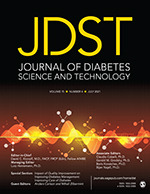Noninvasive glucose monitoring may change future of diabetes management was reported by Michael Monostra for Healio.com/endocrinology, 3 August 2021.
 More than 60 noninvasive and minimally invasive bloodless glucose monitoring products are available or in development, and the devices may become important digital tools for people with diabetes, according to a review article. David C. Klonoff, MD, medical director of the Diabetes Research Institute at Mills-Peninsula Medical Center in San Mateo, California, said noninvasive glucose monitoring devices could be game-changers in the field of diabetes, but several hurdles must be overcome to allow more people to use the products.
More than 60 noninvasive and minimally invasive bloodless glucose monitoring products are available or in development, and the devices may become important digital tools for people with diabetes, according to a review article. David C. Klonoff, MD, medical director of the Diabetes Research Institute at Mills-Peninsula Medical Center in San Mateo, California, said noninvasive glucose monitoring devices could be game-changers in the field of diabetes, but several hurdles must be overcome to allow more people to use the products.
Klonoff and colleagues conducted a review of three types of glucose monitoring devices. Noninvasive optical glucose monitoring is described as a device in which radiation is passed through a vascular region of the body. Noninvasive fluid sampling includes devices in which body fluid is collected without puncturing the skin. Minimally invasive glucose monitoring includes devices in which a sensor provides glucose concentration over an extended period of time with a single insertion into the skin with minimal pain.
Researchers searched PubMed, Google Patents and the Diabetes Technology Society’s three startup showcases for minimally invasive or noninvasive glucose monitoring products. Seven experts in the field of glucose monitoring were also asked to provide names of novel minimally or noninvasive devices they had heard about. Devices receiving FDA clearance or a CE mark were included, as well as products that had a news article or press release published on Google News starting in 2016. All products were classified as noninvasive optical, noninvasive fluid sampling or minimally invasive. For each product, researchers determined the mechanism of glucose sensing, where the glucose sensing is carried out, accuracy, possible interference, measurement cycle, pricing, size, advantages and disadvantages. The findings were published in Journal of Diabetes Science and Technology.
There were 65 products reviewed: 28 noninvasive optical products, six noninvasive fluid-sampling devices and 31 minimally invasive glucose monitoring products. Of the noninvasive optical and fluid-sampling products, none have received FDA approval and four received CE clearance.
“Generally speaking, it’s more challenging, more rigorous to get FDA clearance than CE clearance,” Klonoff said. “FDA clearance demands safety and effectiveness. CE generally demands only safety. You could have a product, in theory, that is safe, it’s not going to hurt anybody or damage them by using it, but it’s just not very accurate, so it’s not very effective.”
Read more: Noninvasive glucose monitoring may change future of diabetes management
Infection-Related Hospitalizations High for Adults With Diabetes was reported by Kristen Monaco for MedPageToday.com, 5 August 2021.
 People with diabetes may face a higher risk for hospitalization for any infection, according to a new study by Elizabeth Selvin, PhD, MPH, of Johns Hopkins Bloomberg School of Public Health in Baltimore, and colleagues. This was largely driven by infections specifically in feet, with a near sixfold higher risk for foot infections among those with diabetes after adjusting for demographic and cardiometabolic risk factors, the group wrote in Diabetologia. However, people with diabetes also saw a significantly increased risk for other types of infections requiring hospitalizations compared with people without diabetes:
People with diabetes may face a higher risk for hospitalization for any infection, according to a new study by Elizabeth Selvin, PhD, MPH, of Johns Hopkins Bloomberg School of Public Health in Baltimore, and colleagues. This was largely driven by infections specifically in feet, with a near sixfold higher risk for foot infections among those with diabetes after adjusting for demographic and cardiometabolic risk factors, the group wrote in Diabetologia. However, people with diabetes also saw a significantly increased risk for other types of infections requiring hospitalizations compared with people without diabetes:
Of note, all subgroups of participants with diabetes had this increased risk for infection-related hospitalization. This included all sociodemographic levels, all races, sexes, and ages, and was true regardless of obesity status and health insurance status, the researchers said. However, young people — defined as those under age 55 — and Black patients had even higher risks for infection hospitalization.
The findings strongly suggest “that enhancing prevention and early treatment of infection in those with diabetes is needed to reduce infection-related morbidity and mortality,” Selvin’s group wrote. “This is especially important given the emergence of the COVID-19 pandemic and the rising rates of hospitalization for infection in the USA, both of which have disproportionately affected people with diabetes.”
Read more: Infection-Related Hospitalizations High for Adults With Diabetes


Sheryl is an official no blood – blood sugar tester. She can spot a low blood sugar from 1500 miles away. She is right about 90% of the time. That makes her as good as most meters.
rick